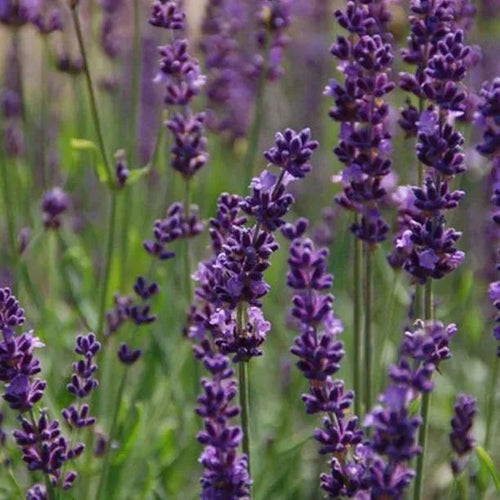Phenomenal Lavender Plants
Phenomenal lavender is a low-growing, evergreen perfumed shrub with beautiful violet-purple flowers. This modern variety's foliage looks better at the end of a rough winter than traditional cultivars like Hidcote, and it flowers earlier too!
The densely packed flowers are held on long spikes, on a bush that's a little taller than most lavender varieties, but without the tendency to flop that many of the bigger bushes have. The flowers are deeply perfumed, with the classic lavandin scent of pot-pourri and soap; they're also a magnet for bees and butterflies. So it's perfect for spring and summer colour and scent, as well as evergreen winter interest.
Highly recommended for humid regions.
Browse our varieties of lavender, other evergreen hedging, or all hedging plants.
Delivery season is weather dependent. There is no point planting lavender out before nighttime temperatures rise as the shock sets it back, so it establishes slower than lavender planted later when the soil is warm.
Features
- The smallest lavenders, in P9 pots, are never shipped before May.
- We aim to ship the larger pot sizes from the end of April, but cold weather can delay delivery into May.
Features
- Earliest Flowering
- Looks good at the end of winter
- Dutch Lavender / Lavandin
- Use: Low hedging / edging, basic topiary balls & shapes
- Flowers: Violet-blue spikes
- Strong stems, don't flop
- Flowering: May to August
- Scent: Strong, lavender
- Leaves: Evergreen, aromatic. Silvery when mature
- Height x Spread: 75cm x 75cm
- Unappealing to deer, rodents
- Drought tolerant when established
- RHS Plants for Pollinators
Growing Phenomenal Lavender
- Aspect: Full sun, South facing
- Soil: Well drained is vital, poorly fertile is preferable
- Soil pH: Above 6.5 is best. Likes chalk
- Hardiness Rating: H5 (to -15C)
- Suitable for the coast and windy locations
- Ideal for container growing
Lavender must have good drainage and close to full sun. It prefers poor soil and thrives in exposed coastal sites.
When established, they're drought-tolerant, but in their first and second year you must water them well, as with any new shrub.
Don't plant lavender out too early in Spring: the cold soil will shock it and set it back. In most years, this means waiting until May.
There are different approaches to pruning, which is necessary to keep your lavender dense and beautiful.
The essential thing is to cut all the new, green growth down to two or three buds typically in early September, around when the last flowers have faded.
A light trim in Spring is optional, but recommended - alternatively, trim this early flowering variety immediately after the first flush of flowers to encourage a strong second wave.
Spacing a Phenomenal Lavender hedge: Plant at 45-60cm apart: closer spacing will give you a solid hedge sooner.
Deer and rodents aren't interested in lavender - they might nibble fresh green Spring growth to test it, but as the foliage matures they ignore it.
Garden Design Ideas
A top cottage-garden plant, bringing in pollinators and filling the warm summer air with its clean, crisp, slightly camphorous scent, redolent of holidays in the south of France. Phenomenal has the added bonus of being an early bloomer, giving a second flush of flowers in late summer. It's a tall lavender, so give it space in borders and room in containers. Use it to edge a wide pathway, where you can brush past and release that stunning scent. Or plant as a low-growing evergreen hedge around a box knot garden, en masse with other varieties and colours of lavender, or in a gravel garden or borders, combined with cottage-garden perennials such as roses (pale pink looks particularly lovely with purple lavender), hardy geraniums, salvias and the like.
For a more contemporary feel, you can use lavenders in block planting to create a chequerboard effect. Try this with rich claret purple berberis, clipped low and neat, or with alternating squares of a white lavender such as Arctic Snow.
History & Trivia
Phenomenal was bred in Pennsylvania, USA, by Lloyd and Candy Traven of Peace Tree Farm, and registered under the name Niko in 2012.
It was featured in Better Homes & Gardens' 2013 Must-Grow Perennial List, and Mr Plant Geek chose it for his Shrub of the Month October 2019.
According to Lloyd, the dramatic discovery happened in a field of 30,000 dead lavender plants destined for the compost. By chance, Lloyd spotted a single branch - called a sport - alive and healthy on an otherwise dying plant! Veteran plant breeder Lloyd knew he'd found something revolutionary, and took cuttings with giddy excitement.
Lavandins are sterile hybrids, crossed from Lavandula latifolia and L. angustifolia.
Their flowers are larger than wild English lavender, so have much more oil. It's the scent most people associate with lavender, most often used in lavender bags, soaps and other cosmetics. Its oil is more camphorous than the L. angustifolia types, so less successful in cookery, but still closer to the L. angustifolia profile than other lavandins.
Lavandin flowers are edible, but much more bitter with camphor than English lavender, so use sparingly.








 Secure, One-Tap Checkout
Secure, One-Tap Checkout
 Hand Picked, Delivered to Your Door!
Hand Picked, Delivered to Your Door! 1 Year Bareroot Guarantee
1 Year Bareroot Guarantee